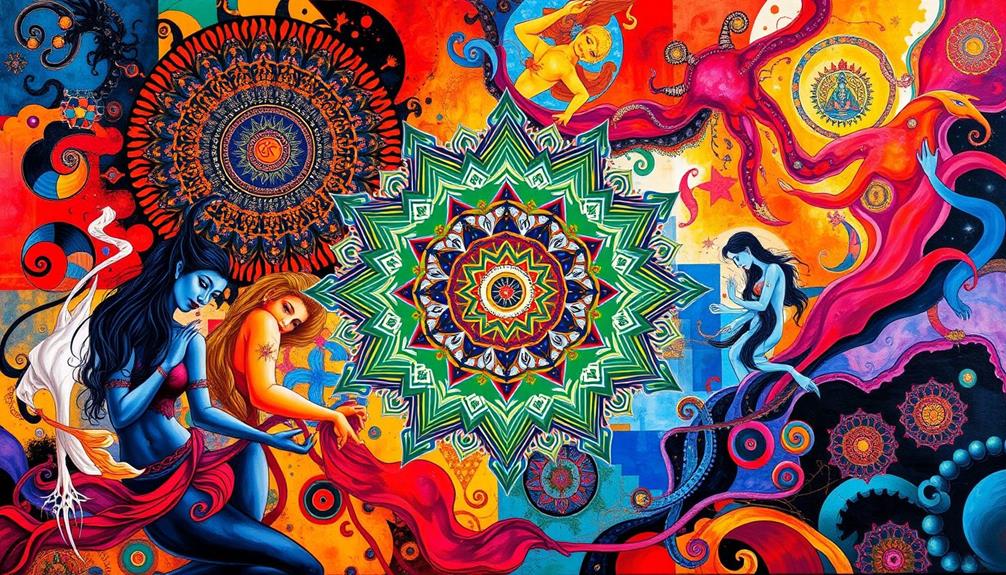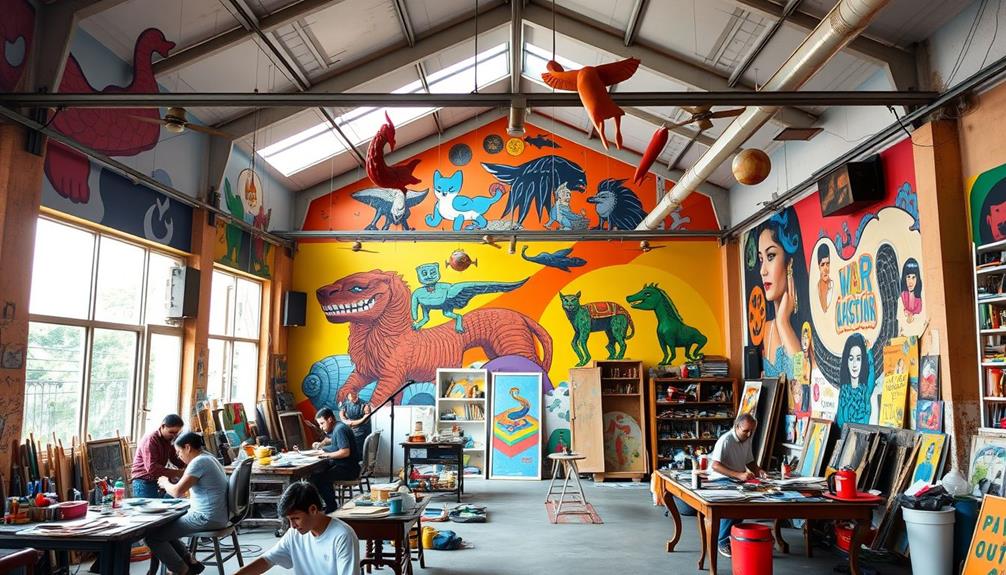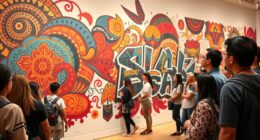Contemporary Indian women artists are breaking barriers by boldly expressing complex themes like identity, gender roles, and socio-political issues in their work. They challenge traditional narratives and redefine societal norms despite facing gender bias and limited opportunities. With artists like Bharti Kher using bindis to prompt discussions on femininity, and Arpita Singh illustrating the complexities of female identity, their art resonates powerfully. These creators often leverage globalization and social media to enhance visibility and connect with broader audiences. Discover the innovations and emerging trends shaping their impact in the contemporary art scene that you won't want to miss.
Key Takeaways
- Contemporary Indian female artists challenge gender norms and societal expectations through innovative practices and diverse mediums.
- Artists like Bharti Kher and Nalini Malani address socio-political issues, reshaping discussions around identity and cultural narratives.
- Community support networks and collaborations enhance visibility and empower women artists, fostering mentorship and shared resources.
- Despite facing gender bias and limited exhibition opportunities, artists like Shilpa Gupta and Rina Banerjee gain recognition on global platforms.
- Emerging technologies and interdisciplinary practices enable new forms of expression, broadening the scope of contemporary art and social engagement.
Overview of Contemporary Female Artists
Contemporary female artists in India are making waves in the art world, with a growing number gaining recognition for their innovative practices. These artists are redefining contemporary art by exploring complex themes related to identity and gender roles. Significant figures like Bharti Kher, Arpita Singh, and Nalini Malani lead the charge, each offering unique perspectives and techniques. Kher's use of bindis and Malani's pioneering video installations showcase how Female Artists of India are pushing boundaries.
Their work often reflects pressing socio-political issues, addressing topics like oppression, migration, and cultural identity. Recent studies indicate the importance of community support in enhancing the visibility of artists, as seen in the rise of networks and collectives support networks that empower women in the arts.
Despite facing challenges such as gender bias and limited access to resources, these artists are reshaping the Indian art landscape. They're gaining visibility in both national and international exhibitions, proving that their voices matter.
Support networks and collectives have emerged to foster mentorship and create inclusive art spaces, allowing for greater collaboration and creative expression. As you explore the world of contemporary female artists, you'll find that they aren't just participants in the art scene but powerful agents of change, challenging norms and inspiring future generations.
Artistic Themes and Expressions
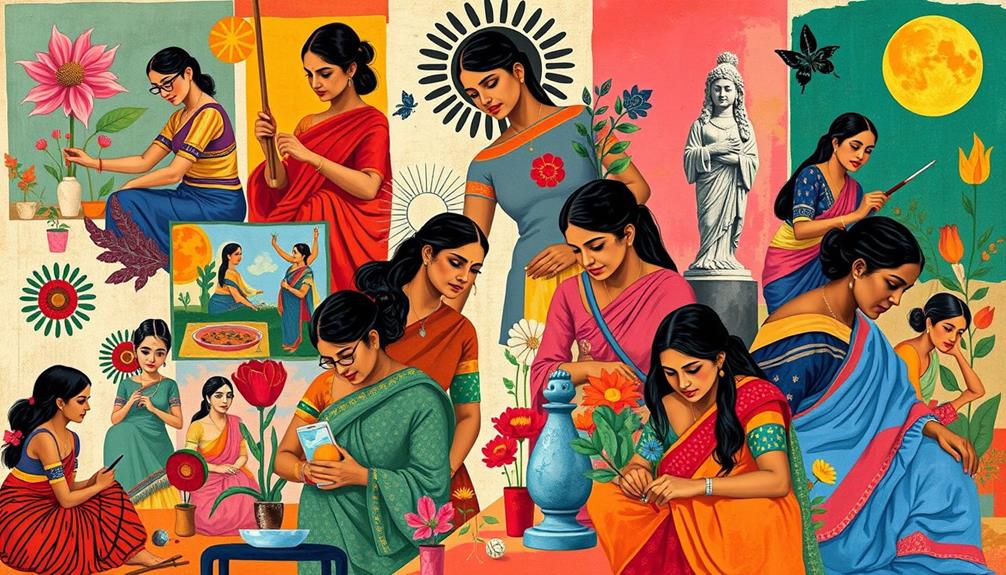
As you explore the artistic themes and expressions of contemporary Indian women artists, you'll notice a powerful focus on gender identity, migration, and environmental concerns.
Their works often intersect with evolving cultural narratives, echoing the sentiments of movements found in the artistic journeys of diverse communities.
These artists challenge traditional narratives and create thought-provoking works that resonate with personal and societal issues.
Gender Identity Exploration
Through various artistic expressions, contemporary Indian women artists are redefining gender identity and challenging societal norms. Artists like Riti Sengupta use staged photographs in her series "Things I Can't Say Out Loud" to highlight the invisibility of domestic labor and reflect on gendered identity within the patriarchal family structure.
The evolving narrative of gender identity in India is echoed in their work, which serves as a response to current social dynamics and expectations, mirroring themes seen in astrological insights that guide personal growth.
Similarly, Mallika Das Sutar's installation "I Can't Bear It" employs hair as a potent symbol to address the anguish of gender violence, confronting societal expectations while intertwining the female body with land through performance art.
Bharti Kher's work prominently features the bindi, a cultural symbol that opens discussions around femininity and societal expectations, making significant contributions to contemporary Indian art.
Jyotsna Siddharth, a queer Dalit feminist artist, explores themes of gender and caste oppression in her performance "The Body as Caste Field," challenging cultural boundaries through traditional markers like the Janeu.
These artists not only confront the impact of gender discrimination but also illustrate the struggles faced by female artists who navigate societal expectations that often prioritize traditional career paths over artistic pursuits.
Their work is a powerful demonstration of the evolving narrative of gender identity in India.
Migration and Home
In exploring the intricate relationship between migration and home, contemporary Indian women artists investigate personal and collective narratives that resonate with their audiences. Moutushi Chakraborty's "Memoirs as Letters" reflects on the trauma of the 1947 Partition, drawing inspiration from family history and postcards. Her work highlights the emotional implications of migration, allowing viewers to confront the complexities of belonging and how these experiences can shape one's sense of self, much like the insights into astrological compatibility that affect romantic attraction.
Similarly, Gopika Nath's "Thoughtnets" emphasizes healing and interconnectedness through found materials, revealing how migration shapes our relationship with the environment. Rina Banerjee blends Indian and Western influences, creating multimedia works that challenge traditional narratives of home and identity, showcasing cultural hybridity.
Moreover, the collective Chander Haat actively supports artists in exploring migration themes while fostering community engagement. They encourage interdisciplinary research that addresses social justice issues, reflecting the broader societal impact of migration.
Through various artistic mediums, these contemporary female artists confront the loss of homeland and the nuances of identity, ultimately crafting a dialogue that resonates deeply within the domains of migration and home. Their work not only challenges perceptions but also fosters understanding and empathy in a world marked by displacement.
Environmental Concerns Symbolism
How do contemporary Indian women artists use symbolism to address environmental concerns? They employ a rich visual language that highlights the urgent issues surrounding ecological destruction.
For instance, Gopika Nath's fiber art incorporates found materials, illustrating the deep connection between human experiences and nature. You'll notice that many Indian artists utilize mixed media, like three-dimensional sculptures featuring nets, symbolizing both entrapment and protection, while also raising awareness about the degradation of marine life.
These artists often draw parallels between their work and the importance of air purifiers in maintaining a healthy environment, emphasizing the need for clean air in a polluted world.
Contemporary female artists, such as Shilpa Gupta, weave symbols and materials that challenge societal norms, merging personal narratives with pressing ecological themes. In their works, embroidery and beading emerge as protective motifs over natural elements, serving not only as a critique of ecological destruction but also encouraging conversations about conservation.
Through these artistic expressions, you can see a growing recognition of climate change's urgency within the Indian contemporary art scene.
Challenges in the Art World

As you explore the challenges faced by contemporary Indian women artists, you'll notice gender bias that limits their visibility and opportunities in the art world.
This systemic issue can mirror the dynamics seen in narcissistic relationships, where individuals may struggle for recognition and validation.
Many struggle with access to resources, making it tough to establish sustainable careers.
This imbalance not only affects individual artists but also shapes the broader artistic landscape.
Gender Bias and Visibility
Gender bias in the art world greatly limits the visibility and opportunities for female artists in India. You might be surprised to learn that studies show women artists receive only a fraction of exhibition space in major galleries. This disparity not only affects representation but also reinforces traditional roles, stifling creative expression.
Here's a breakdown of some challenges faced by female artists:
| Challenge | Impact on Female Artists | Possible Solutions |
|---|---|---|
| Limited Exhibition Space | Reduced visibility in major galleries | Advocate for equal representation |
| Lack of Funding | Difficulty in project execution | Increase funding opportunities |
| Societal Expectations | Pressure to conform to traditional roles | Encourage diverse narratives |
| Balancing Personal Life | Strain between career and family | Promote supportive networks |
| Need for Representation | Underrepresentation in the art world | Create inclusive initiatives |
As you can see, these challenges create barriers that female artists must navigate. However, the ongoing push for greater representation in the art world is vital. By advocating for inclusive spaces, you can help recognize and celebrate the contributions of female artists.
Limited Resources and Opportunities
Maneuvering limited resources and opportunities poses a considerable challenge for female artists in India. You'll notice that gender bias in the art industry often results in considerably lower visibility for women compared to their male counterparts.
With limited access to funding and resources, it becomes tough for you to develop your career, participate in exhibitions, or produce new work. Additionally, societal expectations and cultural norms frequently dictate your artistic choices, compelling you to navigate traditional roles that can stifle your creativity.
Astrology claims to influence personality traits linked to attractiveness, which may further complicate the perception of female artists in the industry. Balancing personal life and professional commitments is another hurdle. Societal pressures often prioritize family responsibilities over your artistic pursuits, leaving you with less time and energy to create.
Moreover, the lack of representation of female artists in galleries and museums remains a critical issue. Your contributions can easily be overlooked in favor of male artists, which limits your recognition and potential for career advancement.
To break these barriers, it's vital to advocate for greater visibility and equal opportunities for women in the art world. By doing so, you can challenge the status quo and pave the way for future generations of female artists.
Globalization's Influence on Art
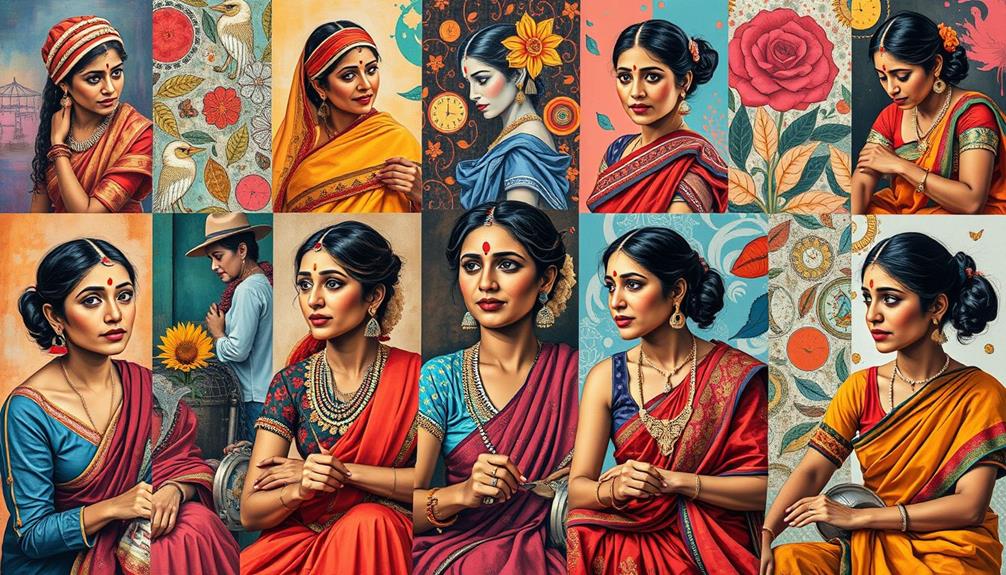
Globalization has transformed the landscape of contemporary art, especially for Indian women artists. With increased exposure to international art movements, you'll notice how these artists engage in cross-cultural exchanges that enrich their work.
The rise of vegan food options reflects a similar trend of cultural exchange, where diverse influences create innovative expressions in various fields. Participation in global art fairs and biennales has markedly raised their profiles, allowing them to showcase their innovative artistic expressions to a broader audience.
Social media plays an essential role in this transformation. It enables Indian female artists to share their work beyond geographical boundaries, connecting them with art lovers and critics worldwide. This access allows them to explore global issues like feminism and climate change, reflecting a dialogue that resonates within contemporary art.
Collaborative projects with international artists have led to groundbreaking works that challenge traditional norms and embrace diverse narratives. You can see how these collaborations foster creativity and push artistic boundaries, resulting in unique perspectives that enrich the global art scene.
As Indian female artists navigate this new landscape, they're not just participants but key players in a dynamic, evolving dialogue that shapes the future of contemporary art.
Future Trends and Innovations
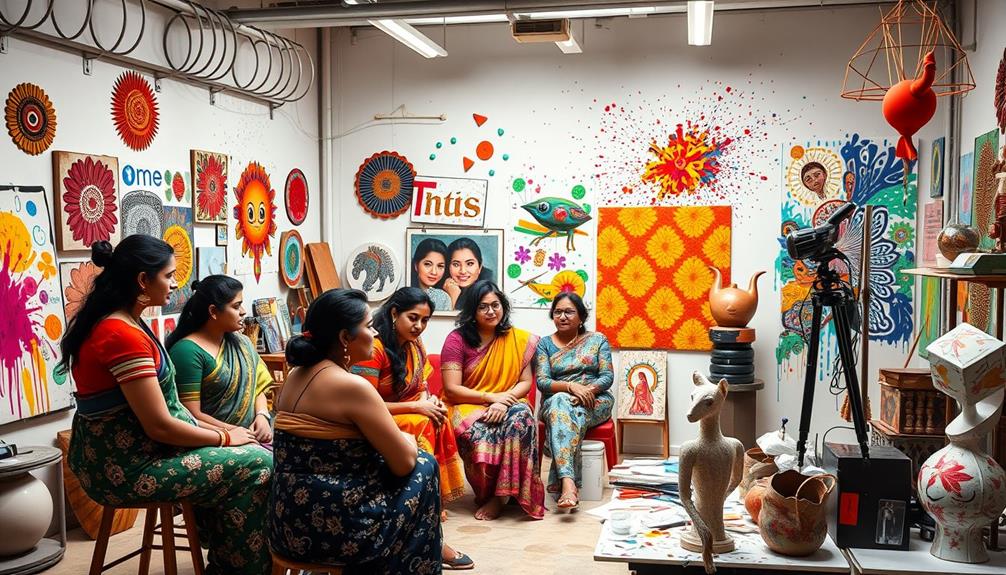
A growing number of Indian women artists are embracing future trends and innovations that reshape contemporary art. By exploring emerging technologies like NFTs, artists such as Manjushree celebrate the female body's natural beauty while challenging cultural conventions. This blend of digital and traditional approaches reflects a broader shift toward interdisciplinary practices.
Moreover, the rise of socially engaged art allows female artists to tackle pressing themes like migration, identity, and ecology. This engagement fosters collaboration and creates supportive networks, ensuring an inclusive environment. Public art festivals and community initiatives serve as crucial platforms, enabling artists to advocate for social change and highlight collective narratives.
Here's a snapshot of these trends:
| Trend | Description | Impact |
|---|---|---|
| Emerging Technologies | Use of NFTs and digital media | Redefines representation |
| Socially Engaged Art | Focus on migration, identity, and ecology | Addresses societal issues |
| Collaboration & Inclusion | Support networks for mentorship | Fosters a diverse art community |
As female artists continue to push boundaries, their innovative practices will certainly shape the future of contemporary Indian art.
Notable Female Artists to Watch
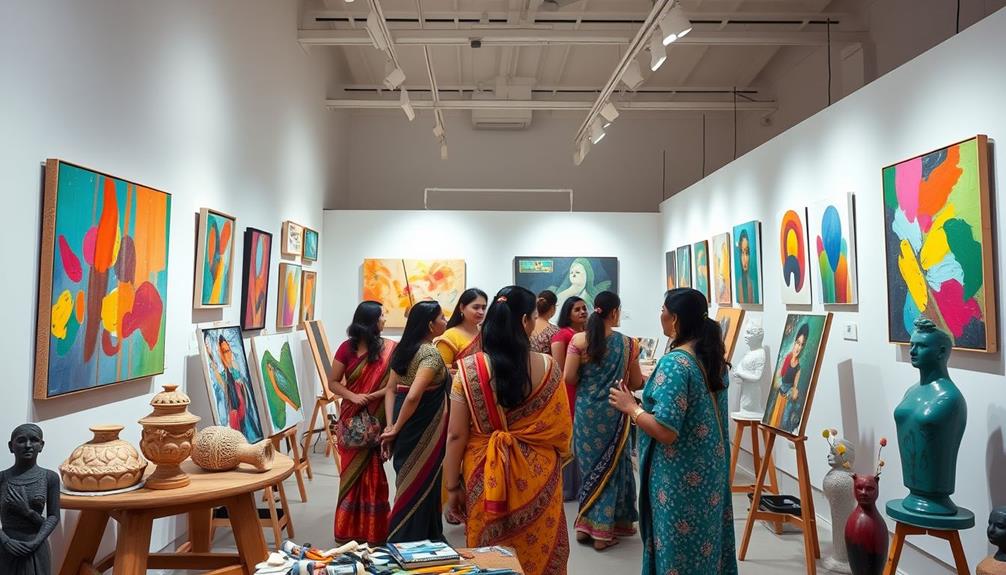
As contemporary Indian art continues to evolve, several female artists stand out for their innovative approaches and impactful narratives. Bharti Kher, for instance, uses bindis in her work to explore themes of identity and cultural heritage, making her a prominent figure in the Indian art scene.
In contemporary design, the blending of modern and rustic elements mirrors the way these artists combine traditional and modern techniques in their work, creating a dialogue between past and present. Natural materials play a significant role in both art and decor, emphasizing a connection to heritage and authenticity.
Arpita Singh captures vibrant imagery that reflects the complexities of female identity and societal expectations, inviting viewers to engage with personal narratives.
Shilpa Gupta challenges boundaries through her interactive installations that address pressing issues like migration and identity. Her work has garnered international attention, showcasing the power of contemporary Indian art on the global stage.
Pooja Bahri takes a socially engaged approach, with installations like "Breathless" symbolizing resilience and the connection to our environment, merging art with activism.
Lastly, Nalini Malani, a pioneer of video art, employs mixed media to confront socio-political issues, particularly the historical trauma of the Partition of India.
These artists aren't just creating art; they're pushing boundaries and redefining narratives, making them essential figures to watch in the contemporary Indian art landscape.
Frequently Asked Questions
Who Is the Most Famous Female Artist in India?
You might consider Bharti Kher as one of the most famous female artists in India. Her innovative use of bindis and exploration of identity and gender themes have garnered her significant recognition both nationally and internationally.
What Obstacles Have Women Faced in Becoming Great Artists?
Women face numerous obstacles in becoming great artists, including gender bias, limited access to funding, societal expectations, and balancing personal responsibilities. These challenges often hinder their visibility and growth in the competitive art world.
Who Is the Indian Woman Artist Best Known for Her Minimalist Abstract Line Drawings?
You might find Rina Banerjee to be the Indian woman artist acclaimed for her minimalist abstract line drawings. Her intricate forms explore cultural hybridity and identity, merging traditional Indian aesthetics with contemporary artistic practices.
What Problems Are Faced by Artists in India?
Artists in India face numerous problems, including limited funding, gender bias, and societal expectations. You'll struggle with visibility, access to resources, and balancing personal responsibilities, which can hinder your creative expression and professional growth.
Conclusion
As you explore the vibrant world of contemporary Indian women artists, you'll see how they're not just breaking barriers but also reshaping the art landscape. Did you know that women now represent nearly 50% of art school graduates in India? This statistic highlights the shift towards inclusivity and innovation. With their unique perspectives and resilience, these artists are poised to lead the way forward, ensuring that their voices and stories continue to thrive in the global art scene.

